#i miss when it was socially acceptable on here to cast wide social nets by tagging all of your interests
Explore tagged Tumblr posts
Text
i need astrology friends hello!!!!!!!!!!!!!! fuckin. anyone out there
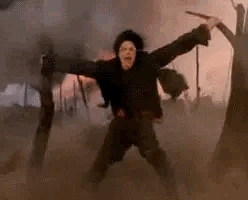
#james.txt#astrology#i miss when it was socially acceptable on here to cast wide social nets by tagging all of your interests#idk this blog has not been v astrological but i'm also too lazy to make a sideblog#flashing gif cw
12 notes
·
View notes
Text
farran rereads lost lagoon: chapters 3-4
- a shot-put ball, according to my cursory research, weighs in the neighborhood of 6-16 pounds. leila howland expects me to believe that princess “hoisted an adult woman 70 ft into the air on the daily with nothing but a pulley and raw upper body strength” rapunzel has a hard time picking up a shot.
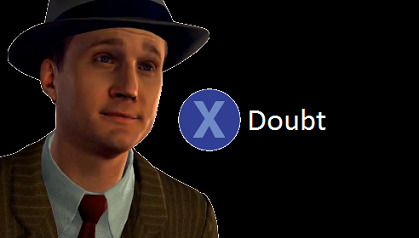
anyways
- rapunzel thinks about how she used to talk to herself in her tower when she was isolated (and lonely) but stopped once she came to corona, and this girl looked like she was talking to herself, and it gave rapunzel this weird sense of familiarity! now what in the world could that mean? its so subtle i can’t quite put my finger on it.
again, romance novel.
less sardonically - i will say that tts cass has never struck me as an especially lonely person. yes, rapunzel is quite possibly her first ever close friend, but cass also appears to be on pleasant terms with her coworkers and has at least one or two friendships or mentor-type relationships among the guards (stan and pete). animals in tts are anthropomorphized enough to qualify as humans, and cassandra is unequivocally friends with owl and fidella. she is friendly if not friends with at least one coronan citizen (monty). she’s utterly unfazed by crowley’s crabbiness. she’s able to get along with the pub thugs. in vardaros she befriends vex with ease and makes herself right at home among the citizenry at large. there is zero friction between her and lance - at most she rolls her eyes when he’s being ridiculous. and out of the main cast, cassandra is the one who seems closest to varian in s1 - like, she has actual bonding moments with him.
THE POINT BEING, cassandra may not have a lot of close friends, but she is nevertheless personable and demonstrates the ability to adapt herself to suit a variety of social environments. maybe i’m projecting here - i have very few close offline friends because my preference for in-person socialization is for it to be very casual - but taken together this doesn’t scream ‘lonely person’ to me. it instead says ‘person who finds social fulfillment in a wide net of friendly acquaintanceships’ and possibly also ‘person who finds close, emotionally intimate relationships worthwhile but very demanding to maintain, and so seldom or never seeks them out.’
this, absolutely, a very subjective reading of her character - it is just as plausible for cass to be someone who is socially competent but feels inwardly unfulfilled until rapunzel comes along. but even in that reading, this implication that cassandra is as deeply lonely, as thoroughly isolated in corona as rapunzel was in her tower is baldly absurd.
- i think i will have more thoughts about how arianna is characterized and the relationship she and rapunzel have with each other later in the story. for now it feels rather mechanical, and like arianna exists in the story to facilitate cassunzel happening.
- cassandra comes across to me like she has an anxiety disorder written by someone who doesn’t quite know how to convey how that feels? she catastrophizes: what if rapunzel thinks cass attacked her? will she get in trouble? but then she stops to make snide comments about rapunzel’s security detail ‘[falling] down on the job’ and concludes with an impressive amount of certainty that rapunzel isn’t going to make a big deal of it, after all. that… isn’t how anxiety works?
then, immediately, she finds a note from her father scolding her for slacking off—making it clear that she is indeed in trouble, like she feared—and her response is to scoff and throw it away. zero concern about being in trouble. zero worry about the consequences she might face for refusing the pointed “offer” of being rapunzel’s lady-in-waiting. like… this isn’t anxiety. i’m positive it’s meant to convey anxiety, but it comes across as cassandra just being… melodramatic and rude and grumpy. like a teenager. it’s unpleasant. and it bears very little resemblance to tts cass, who expresses a clear and consistent anxiety regarding the security of her job and the looming threat of a convent.
- secondly: “Friedborg reported that you missed your afternoon duties AGAIN. Please be advised that this is unacceptable. The queen is looking for a lady-in-waiting to serve Princess Rapunzel. It would be a great opportunity for you, and you must show the queen how prepared you are to train her in the ways of the court.” i am 100% convinced that howland thought cass was rapunzel’s age or younger. if friedborg is effectively cassandra’s direct supervisor, and she is reporting absences to cassandra’s father instead of addressing this with cassandra directly, the only explanation that makes sense is that cassandra is not of legal age.
- “Ladies don’t wield weapons, lead military strategy meetings, or race on horseback. Ladies do needlework, flower arranging, and hairstyling.”
sighs.
i am not going to argue that corona, in any incarnation, isn’t culturally sexist. it is. there are no women in the guard, no women in trades, no female business owners in the vein of monty or xavier or feldspar. besides rapunzel and arianna - who as the monarch’s spouse has very little in the way of actual political power - there are no women in the upper echelons of the government. besides cassandra, the only gnc women around are criminals. cass is denied even a chance to join the guard for no evident reason, even though her father allows eugene - a man he openly despises - to take the tests and then begrudgingly hires him when he passes. no one sees an issue with this, even though cassandra is demonstrably overqualified.
however.
howland makes this cultural sexism explicit text, and she does so in such a way that it implies something pretty horrifying about the already pretty horrifying corona-saporia unification backstory.
i am talking, of course, about general shampanier. you know, the female saporian general whom herz der sonne married when the two kingdoms were unified. the female saporian general who personally dueled der sonne for hours, according to under raps. the female saporian general who, forget military strategy meetings, led an entire goddamn army. i will accept the possibility that shampanier did not ride horses, because rapunzel’s return suggests that saporians have some sort of cultural objection to that. but this book predates rapunzel’s return by a large margin, and it isn’t canon anyway, so odds are the general shampanier of this story rode a warhorse at some point or another in her illustrious career of being the general of an army!!!
this woman - general shampanier - became the queen, the wife of arguably corona’s most historically important king, at a defining moment in coronan political and cultural history. tts and lost lagoon would both have us believe that this was a romantic, peaceful union between two people and two nations, but a few hundred years later - this. ladies don’t fight. ladies don’t belong in the war tent. ladies don’t ride horses. cass takes these things for granted as facts of life. but general shampanier did all of those things, and she did them extremely well, and she became corona’s queen.
WHAT HAPPENED?! WHAT HAPPENED TO SHAMPANIER’S LEGACY?
how did corona go from a warrior-queen to this, in just a few hundred years? the most plausible answer is that the background radiation of sexism and, perhaps, anti-saporian bias was powerful enough to unravel any cultural impact she may have otherwise had, deep enough to render her an outlier, an aberration, an exception to the rule that women do not act like that.
even arguing here that ‘lady’ specifically means ‘noblewoman’ doesn’t add up - because, again, general shampanier became THE QUEEN. you don’t get more noblewoman than that!
it feels unfair to judge this book with details added in season 3—such as the fact that shampanier is evidently not buried with herz der sonne—but this total lack of a cultural impact from general shampanier, queen of corona, feels very telling even without taking those tidbits of extra-textual information into consideration.
and good god, saporia hasn’t even properly entered the narrative yet! this is only the tip of the proverbial iceberg!
*deep breath*
moving. on.
- continuing the theme of cass being a child larping as a guard recruit: she has a closetful of weapons which she maintains to the exacting standards of the handbook, but skips out on her job to “train” in secret because evidently she’ll do ANYTHING to get on the guard except, you know, demonstrate a modicum of responsibility with the job she has now.
- moreover while i think cartography is a neat hobby for cassandra to have, it… doesn’t make a lot of sense if it’s part of some nebulous plan to ~prove herself worthy~ of being on the guard. like, cartography straight up isn’t a relevant skill, and while knowing the countryside could certainly be helpful for guard work in the event a criminal goes to ground in the wilderness, it’s like… it’s like if i applied for my current job, which is in software/tech support, by focusing an intensive amount of energy on teaching myself spanish. fluency in spanish is a useful skill and one that i could turn into an asset within the bounds of my current job, and it might be the deciding factor in me getting hired over someone else with equivalent experience and skill in computing and tech support (which is what the job involves) because, yes, some of our clients are ESL spanish-speakers. but it’s—there’s a disconnect. if i were in a tight competition to get this job i would be pouring my time into sharpening my programming skill and polishing up a portfolio of relevant work. i wouldn’t be devoting hours upon hours to learning spanish. right?
on the other hand—if cartography is a hobby cassandra is passionate about, and she’s 16 or 17 or 18 and she really likes the idea of being on the guard and really feels like she can do it and is bored with her dumb teenager job and desperate to get her dad to make her a guard without actually grasping what being a guard entails or the kind of work it involves or what she actually, realistically needs to do to have a shot, then… yeah, skipping work to play pretend with her weapons and convincing herself that her favorite hobby is totally going to prove to her dad that she’s ready to be a guard!!! makes perfect sense. it’s no different from tts varian tunnel visioning so hard on this fantasy of ‘i’ll surprise my whole village with hot running water and then my dad will be proud of me!!!’ that he neglects basic safety measures and accidentally blows the whole system up. it’s not realistic. it’s a fantasy. it’s play.
- the only time cassandra brings up eugene’s criminal past in tts is to mock him for being a loser. like. literally. the plot of fitzherbert pi kicks off when she calls him a “two-bit hood” and then when he fires back that flynn rider was a LEGEND!!! she fires back “key word being was. and… what is it you do now?” and that’s the only time she brings it up. granted this is 6-7 months into their relationship but… still, frankly i never got the impression that “former thief” was anywhere close to the top of cassandra’s list of reasons for hating eugene. he’s just a dick. she doesn’t like him because he’s a huge selfish jerk and she warms up to him after her starts behaving better.
- rapunzel goes to the ty lee school of flirting. just… laugh really hard at everything your crush says even if it’s not funny.
- despite my… intense and rapidly growing dislike for how cassandra is characterized in this book, her experiencing an actual physical reaction when rapunzel enters her space without permission is good. it’s about the boundaries. it has always been about the boundaries, and rapunzel crossing them, and the intractable messiness that arises from that.
- in fact: how many times does rapunzel cross boundaries in just this one little scene? oh, let me count the ways!
1 - when cassandra goes to shut the door, rapunzel ducks under her arm to enter the room. (eugene attempts to enter as well, but cass succeeds in blocking him.)
2 - missing or ignoring cassandra’s first “go away” hint about only playing individual sports.
3 - missing or ignoring cassandra’s second “go away” hint (“I let the silence get awkward.”)
4 - arranging cassandra’s invitation to the feast of elodie the great with the captain beforehand, so cass can’t use him as an excuse to decline.
5 - missing or ignoring cassandra’s obvious discomfort with this news, taking cassandra’s attendance at the feast as a done deal, and skipping straight to asking cassandra to sit next to her.
6 - in response to cassandra’s very diplomatic signal of not wanting to do that (“I sit wherever I’m assigned”), she declares that she’ll make sure cassandra is assigned to sit next to her.
7 - touching without permission, which makes cassandra flinch.
all of which results in cassandra making what she considers to be a “tactical surrender.” and then shutting and locking her door, because she feels so rattled. as i recall, lagoon is actually a lot mellower on the boundary violations front - and rapunzel actually learns better over the course of the story, which is probably the biggest reason that lost lagoon is not canon and cannot be canon to tts - but it feels worth writing this sort of thing out because, well. it is one of the dead horses i keep clobbering.
21 notes
·
View notes
Photo



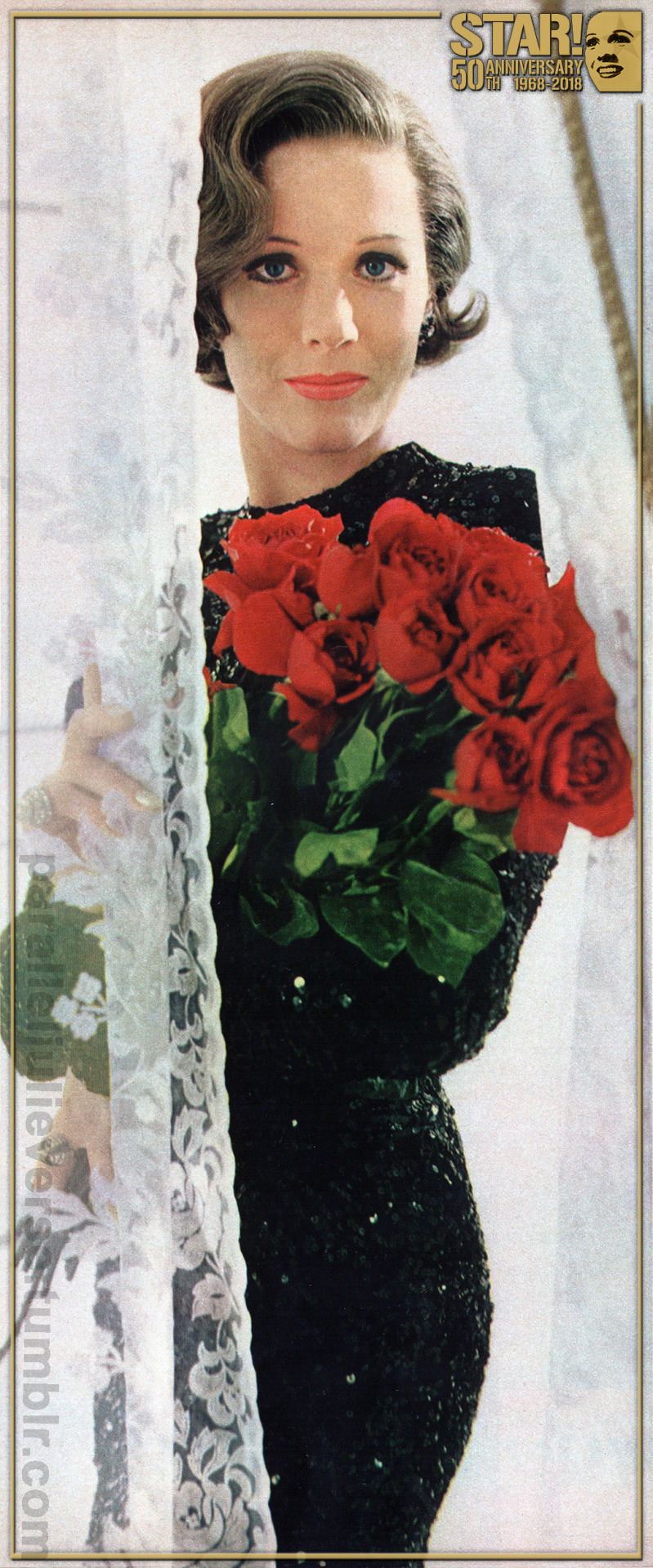
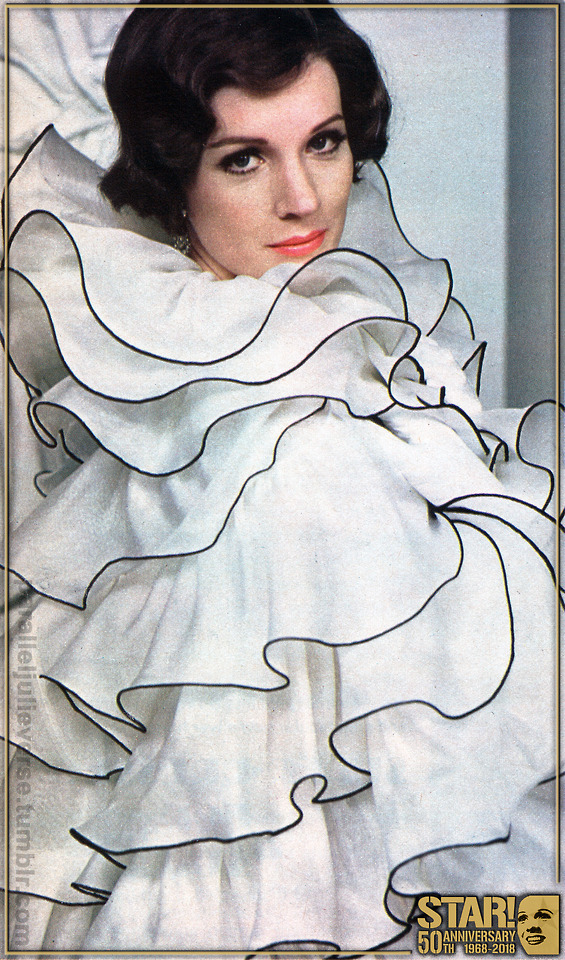
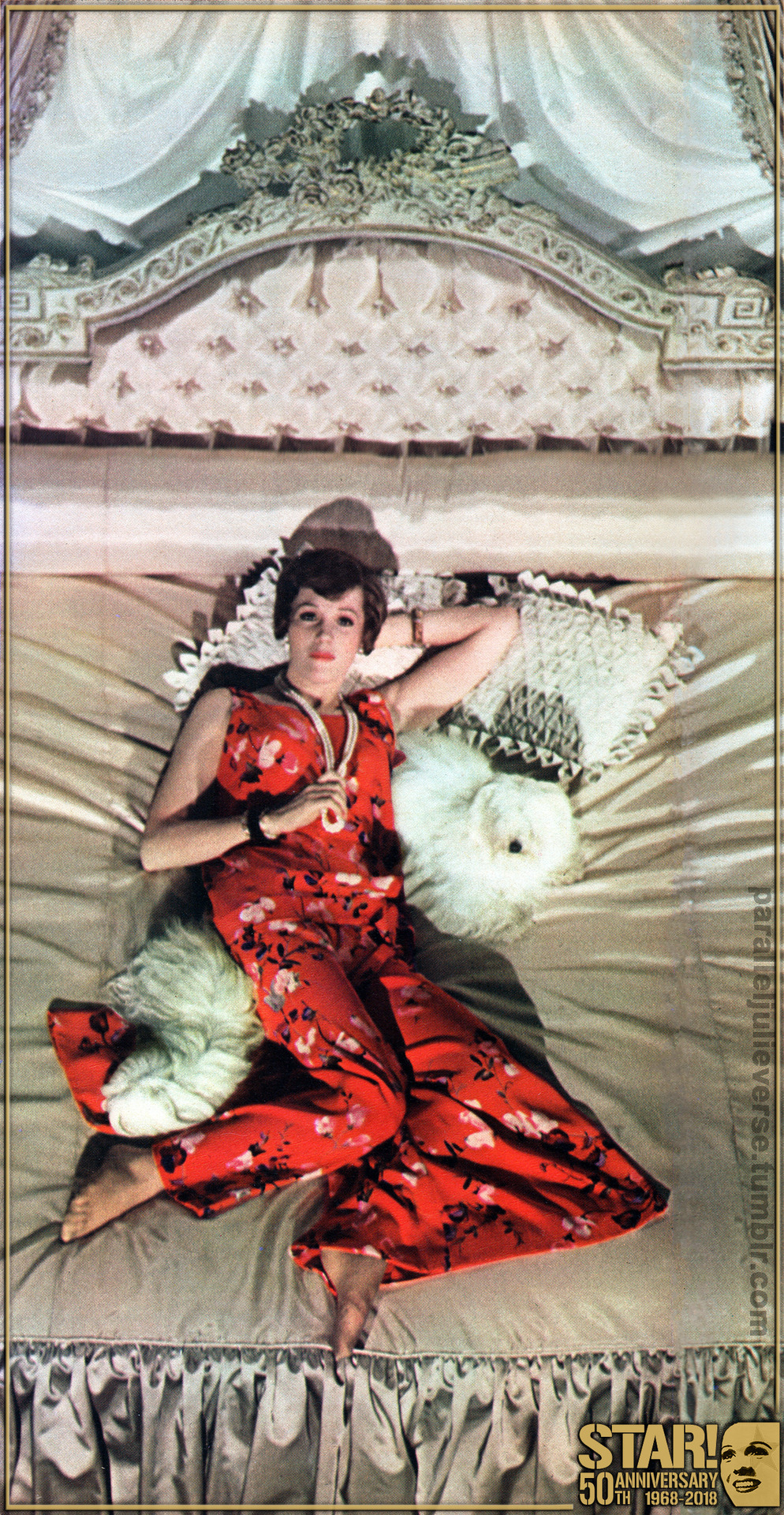
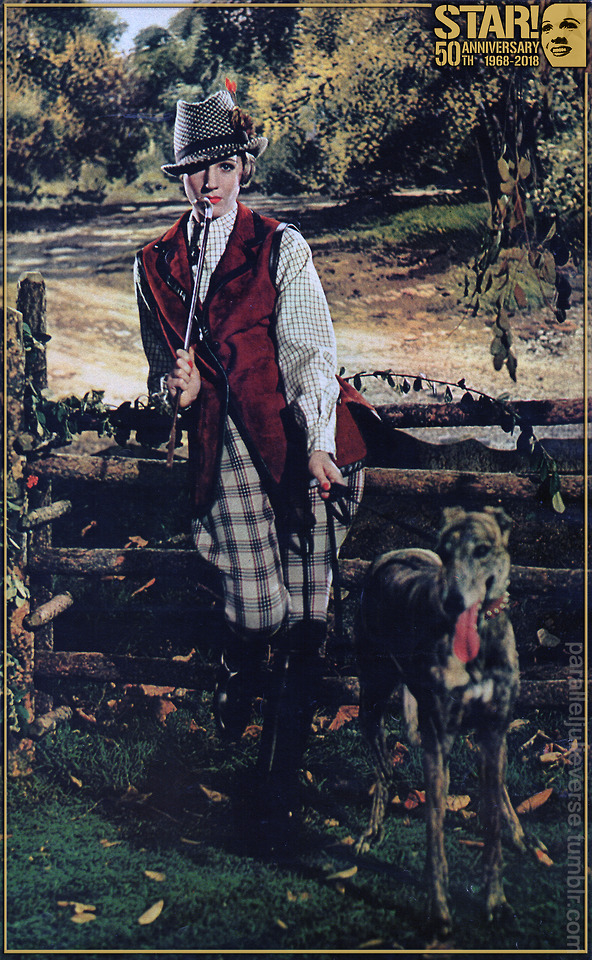
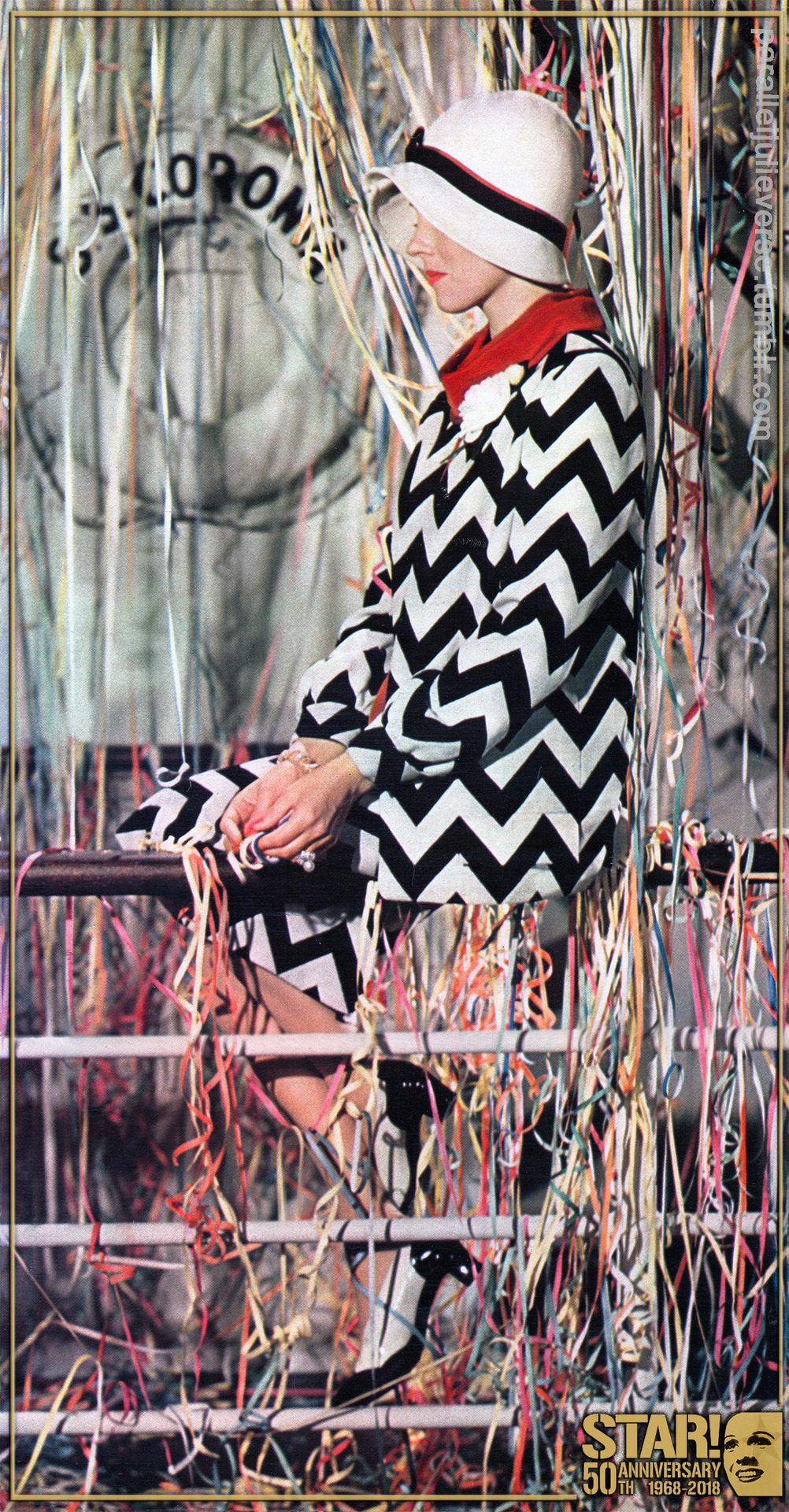
Star!, the 1968 musical biopic of Gertrude Lawrence celebrating its 50th anniversary this year, signalled a substantial shift for the on-screen persona of Julie Andrews. Although the actress had tackled slightly ‘darker’ roles in some of her previous dramatic films –– notably, The Americanization of Emily (1964), Hawaii (1966) and Torn Curtain (1966) –– her star image in this era was primarily defined by the trio of hit screen musicals –– Mary Poppins (1964), The Sound of Music (1965) and Thoroughly Modern Millie (1967). Together these family-friendly blockbusters cemented a popular ‘nice girl’ image humorously described by one commentator of the time as “Miss Sunshine of the Sixties” (Coleman, 118).
The part of Gertrude Lawrence, by contrast, was no sunny musical ingenue. As depicted in Star!, she is an ambitious arriviste driven to theatrical and social success at all costs. A self-absorbed hedonist, Gertie drinks, swears, and leaves a trail of broken romances and –– perhaps, most subversive vis-à-vis the traditional Julie Andrews screen image –– abandoned children in her wake. Much of the film’s commercial underperformance has been attributed to the difficulty audiences of the time had in accepting Julie Andrews in such a radically atypical role (Kennedy, 154; Silverman, 131). Even the Dame herself subscribes to this theory, musing in retrospect that:
“It was a time of enormous change for me and for movies…And people then were not ready to accept me in an unsympathetic role like Gertrude Lawrence in Star!” (Anderson, 27).
Things weren’t possibly helped much by the film’s pre-release publicity campaign. The second of two films that Julie was contracted to make for Twentieth Century-Fox, Star! was initially announced in late 1964, before her first film, The Sound of Music was even in the can (Scheuer, V-15). By the time Star! was ready for production, The Sound of Music had become the highest grossing film of all time and Fox spared no expense in promoting their new big Julie Andrews musical. The studio assigned not one but two Publicity Directors to handle the film, Howard Newman and Mike Kaplan. Together they helmed what was described as “the biggest publicity barrage in Hollywood history” with countless media releases, photographs, interviews, and PR stories (Edwards).
From the outset, Fox was quick to promote Star! as a reunion of the “dream team” behind The Sound of Music: star Julie Andrews, director Robert Wise and producer Saul Chaplin (”Movie Call Sheet,” IV-10). “Julie Andrews…returns to singing and dancing in Star! with the same two movie makers who guided The Sound of Music,” trumpeted a widely syndicated press release to mark the start of shooting in early 1967. “If any picture is likely to match The Sound of Music in public popularity, it will be Star!” (Kaplan, B-10). As a purely attention-grabbing marketing strategy, it made sense to play up The Sound of Music connections, but it arguably served to foster false expectations that Star! was set to be another upbeat family musical.
During the film’s long 18 month production, media articles started to hint that Star! marked a change of pace for Julie. However, the focus was largely on change at the level of visual style with Star! framed as little more than a cosmetic makeover for “our Julie”:
“To play Gertrude Lawrence should give Julie Andrews a much deserved chance to prove what a charmer she is. On the screen Julie has been hidden under nun’s robes and missionary muumuus for the past two years…In Gertrude Lawrence’s chiffon and ostrich she should come alive as a glamorous woman instead of a wholesome girl” (Sheppard, D1).
Or again:
“In ‘Star!’ [Julie is] playing her first glamorous role, a musical comedy star based on the life of Gertrude Lawrence. Donald Brooks designed a $250,000 wardrobe for her, not including the $2,500,000 worth of real jewels supplied by Cartier’s in New York…It’s a chic and elegant Julie you’ll be seeing in ‘Star!’, singing more than two dozen songs by Noel Coward, Kurt Weil, George Gershwin, Cole Porter, and other great composers” (Sherman, B-3).
The net effect of these widespread media reports was to present Star! as a variation on the classic Cinderella ‘makeover’ musical which had been central to Julie’s stardom from My Fair Lady to Thoroughly Modern Millie (Cantu 2015). Small point that Julie’s new character was possibly more Wicked Stepmother than Cinderella.
One of the most spectacular examples of the promotional framing of Star! as fairytale makeover is this lavish cover spread from the popular US weekly magazine, Look. Hitting the stands in mid-September 1967 –– nine months before Star!’s UK premiere and a full year before its US release –– the magazine spread is essentially a photographic panegyric to Julie as ‘glammed up’ princess with costume designer Donald Brooks cast in the the role of symbolic Fairy Godmother:
“At this point, Star! is only half-born…However, publicity on the Robert Wise production for 20th Century-Fox starts now, and its uproar will echo immediately through the world of fashion. Julie will wear 124 different costumes in Star! They are all glamorous, a word invented for the likes of Gertie Lawrence and captured now by designer Donald Brooks. For women who do not want to follow the hippie road or slick moon-blast to fashion, here is salvation” (Zill, 63).
In glossy full page shots by famed photographer, Cal Bernstein, Julie is showcased in some of Brook’s most lavish costumes, set against a series of fantasy backdrops courtesy of the Fox prop department: Julie as darling flapper, as ‘swellegant’ society lady, as landed gentry. It’s a stunning preview of "Julie’s Dazzling New Look” but it offers nary a hint about “Julie’s Acidic New Personality”!
On its release, reviews of Star! were sharply mixed. The film garnered more praise than is often remembered, but among the many brickbats, critics were quick to highlight the jarring disjunction between Julie’s received star image and her waspish new role. In a typical example, Renata Adler* of The New York Times wrote:
“Miss Andrews, who plays Gertrude Lawrence, is not at her best in this one. There is some sort of clash between her special niceness and innocence and the attitude that the film, directed by Robert Wise (of ‘The Sound of Music’), has toward the star of ‘Private Lives’ and ‘The King and I’" (Adler, 21).
Could this type of response have been averted with a more careful pre-release framing of the film and its casting of Julie ‘against type’? Possibly, but then Star!’s problems were never limited to the film’s surprise revision of Julie’s ‘girl next door’ persona. Failure may be a proverbial orphan but in the case of Star! it most definitely had ‘multiple fathers.’ Some of the other factors operative in the film’s underperformance will likely be flagged in future posts but the Look magazine cover from 1967 provides a telling insight into one of them. The cover’s uneasy juxtaposition of Julie’s fantasy glamour makeover alongside headline allusions to the war in Vietnam and rising murder rates serves a symbolic snapshot of the rapidly brewing social tumult that would rise to engulf America and bedevil the reception of Star! and other big screen musicals of the era.
Variously dubbed ‘the year that rocked the world’, 'the year of awakening’, ‘the year of revolt’, 1968 was nothing if not a watershed moment of profound social upheaval. As post-war baby boomers came of age and countercultural youth movements reached critical mass, “there occurred a spontaneous combustion of rebellious spirits around the world” united by “a sense of alienation from the established order and a profound distaste for authoritarianism in any form” (Kurlansky, xvii). In such a context, the complexion and tastes of movie audiences were, like the times, a-changin’ fast. Small youth-oriented and iconoclastic social realist films like The Graduate (1967) Bonnie and Clyde (1967) and Easy Rider (1969) were the new order of the day and, almost overnight, big budget musicals like Star! were deemed woefully old-fashioned, even irrelevant.
In a remarkably hostile piece that is possibly more cultural symptomatology than actual film review, Robert Kotlowitz, resident critic for Harper’s magazine, took Star! to task for what he saw as the film’s reactionary obliviousness to America’s changing zeitgeist. The filmmakers, he writes, seem to:
“have simply strolled over to Hollywood’s immense fantasy bin –– in which slivers of our national psyche lie buried –– and casually plucked dozens of the gaudiest clich��s from the dust and packaged them as a Technicolor extravaganza…[Star!] is less concerned with the biography of Gertrude Lawrence than with using the rags-to-riches, triumphs-and-heartaches outline of her story to define an extinct type of glamor, the ideal of an anti-serious and pre-pop generation…it’s impossible to imagine the John Lennon legend ever receiving this kind of treatment “ (169).
Not sure about John Lennon –– though fifty years after the fact, one would be hard pressed to claim his legend hasn’t been subject to its own forms of clichéd idealisation –– but Kotlowitz’s diatribe certainly gives a sense of the extent to which Star! suffered substantial fallout from the era’s rapidly transforming social climate.
And, pace Kotlowitz’s testy dismissal of the film as “extinct glamor”, Star! possibly offers its own eloquent rejoinder when, in a spirited defence of Gertie’s mercurial eccentricities, Noël Coward grandly declaims:
“I know she’s maddening, infuriating and impossible…but she’s also probably the most beautiful and entrancing creature ever to walk onto a stage. Glamour is a very overworked and quite indefinable word but I think the world could do with a little of her brand of it at the moment” (Fairchild, 142).
Five decades on, some of us are still entranced by the glamour of Star!…warts and all! ___________________________
Notes:
* It was widely reported that Renata Adler left the press screening of Star! early due to illness. The fact that she went ahead to file a negative, and dismissively short, review despite only having seen half the film prompted an outraged letter to the editor from Twentieth Century-Fox head, Daryl F. Zanuck. It was one of several gaffes that marked Adler’s brief but tempestuous tenure as resident film critic at The New York Times (Roberts, 181ff).
Sources:
Adler, Renata. “Screen: ‘Star!’ Arrives: Julie Andrews Featured in Movie at Rivoli.” The New York Times. 23 October 1968: 21.
Anderson, George. “Andrews Garned in New Image.” Pittsburgh Post-Gazette. 23 March 1982: 27, 30.
Cantu, Maya. American Cinderellas on the Broadway Musical Stage: Imagining the Working Girl from Irene to Gypsy. London: Palgrave MacMillan, 2015.
Coleman, John. “Per Adua ad Julie.” New Statesman. 26 July 1968: 118.
Edwards, T.J. “The Saga of ‘Star!’”. Star! Special Edition LaserDisc. Beverley Hills, CA: Twentieth Century Fox Home Entertainment, 1993.
Fairchild, William. Star! Unpublished screenplay. Final version: 26 January 1967.
Kaplan, Mike. “Julie Andrews to Film ‘Star’.” The San Bernadino County Sun. 29 April 1967: B-10.
Kennedy, Matthew. Roadshow!: The Fall of Film Musicals in the 1960s. Oxford: Oxford University Press, 2013.
Kotlowitz, Robert. “Films: ‘Star!’, ‘Finian’s Rainbow’, ‘Hot Millions’.” Harper’s. Vol. 237. No. 1422, November 1968: 168-171.
Kurlansky, Mark. 1968: The Year that Rocked the World. New York: Random House, 2004.
“Movie Call Sheet.” The Los Angeles Times. 24 May 1965: IV-10.
Roberts, Jerry. The Complete History of American Film Criticism. Santa Monica: Santa Monica Press, 2010.
Scheuer, Philip. “Julie Andrews Just Right for Gertie.” The Los Angeles Times. 2 December 1964: V-15.
Sheppard, Eugenia. “Julie Will Play Gertrude Lawrence Role.” The Honolulu Advertiser. 7 November 1966: D1.
Sherman, Eddie. “’STAR’ Communique.” Honolulu Advertiser. 8 August 1967: B-3.
Silverman, Stephen M. The Fox That Got away: The Last Days of the Zanuck Dynasty at Twentieth Century-Fox. Seacusus, NJ: Lyle Stuart, 1988.
Zill, Jo Ahern. “Julie Plays Gertie.” Look. Vol. 31, no. 19. 19 September 1967: 63-68.
Copyright © Brett Farmer 2018
#julie andrews#star!#fiftieth anniversary#star50#gertrude lawrence#hollywood#musicals#donald brooks#20th century fox#robert wise#1968#look magazine#cal bernstein#fashion#photography#film criticism
45 notes
·
View notes
Photo

Ms. Marvel #27 Review
spoilers spoilers spoilers spoilers spoilers spoilers spoilers spoilers spoilers
It’s the courageous Kamala Korps versus the dreaded Inventor as the Teenage Wasteland story-arc continues from the creative team of G. Willow Wilson, Nico Leon and Ian Herring. Quick recap and review following the jump.
Zoe is missing! She had donned her makeshift Ms. Marvel costume and thought she could take on The Inventor on her own. She’s been gone for a while now and her friends are quite worried. Fortunately, Zoe is rarely without her phone and Nakia has the technical wherewithal to triangulate the global positioning system on Zoe’s phone and lead Red Dagger and The rest of the Kamala Korps to her location.

Nakia, Mike and Gabe are looking pretty fly in their ersatz Ms. Marvel costumes; though still outshine by The Red Dagger’s dreamy hair and superior parkour skills.

Not too far away, Zoe finds herself tied up alongside her codger compatriot, Roger, in The Inventor’s layer. The narrative catches up with her just in time for The Inventor to go off on a rather standard issue super villain monologue.
The Inventor’s whole raison d'etre is all about the streamlining of society wherein the less useful members of the population are used as a source of much needed energy for those he deems worthy and useful.

In his first scheme, The Inventor had abducted a group of teenagers, seeing them as shiftless parasites on society better used as energy producing batteries. He was foiled in this plot by Ms. Marvel in one of her first adventures. Having recently been released from prison, The Inventor has modified his plans, now setting his sights on seiner citizens, whom he also sees as providing no value to society as a whole. It’s a weird hang-up and, despite what The Matrix movies might have us believe, human bodies actually make for rather poor batteries. All of that aside, The Inventor does possess a good deal of inventive prowess and has been able to use the various old folks he’s collected to power a bevy of oddly cobbled together monstrosities.

The Inventor’s monologue in interrupted by the timely arrival of The Dagger and the Kamala Korps. Although these young heroes are a lot better at striking impressive poses than they are fighting monster and all manner of mayhem ensues as the Inventor sicks his creatures on the interlopers. And herein we’re treated to a truly wonderful panel illustrated by Nico Leon and Ian Herring showing poor Gabe being chased be a mechanized pineapple… it’s moments like this that remind me why I so love comics :3

Zoe is able to free herself and joins the fight just in time to heroically save Nakia from being zapped by a giant cyborg turtle. It’s crazy… When the dust settles, the heroes have saved the abducted senior citizens and The Inventor and along with many of his monstrous creations have escaped into greater Jersey City. Although they saved the day, Red Dagger is forced to admit that they all might be a bit out of their depth. They can fill in for the real Ms. Marvel when it comes to thwarting muggers and purse snatchers, but a legitimate super villain is clearly it of their league; they’re going to need some help.

And fortunately, Mike has an idea about how to get it.
Way back in the Civil War II story arc, Ms. Marvel had a terrible falling out with her hero and inspiration, Captain Marvel. Captain Marvel’s effort to utilize the predictive powers of Ulysses to stop crimes before they happened led to calamitous results, including poor Bruno being severely injured. It was the last straw and Ms. Marvel quit Captain Marvel’s junior preventative justice squad. As she did, she tossed away the signal device that could be used to call the Captain in case of emergency.
Mike had secretly watched this all go down and she went and retrieved the signal device as a memento for safe keeping. Having collected it from her home, she and the gang now stand on a rooftop and use it to call for Captain Marvel.

The good captain arrives with her usual panache for dramatic entrances; and Leon and Herring do not miss the opportunity for a very cool splash panel.

At first Captain Marvel seems irked. Why is it that these cosplay kids have called her? They better not be wasting her time… And yet the reason for her being beckoned becomes quite evident as they look out on the Jersey City skyline in time see a series of green mushroom clouds detonating all over. Clearly the Inventor has triggered his engage and it looks to be disastrous.

Whether or not Captain Marvel and the Kamala Korps will be up to this new challenge remains to be seen and will have to wait until the next installment as it is here that the issue ends with the promise of conclusion next month.
Another fun ride with lots of great moments… although at this point I’m definitely starting to miss the real Kamala. The issue starts off with a quick prologue showing Kamala’s lunchtime buddy, Neftali, and his ongoing search to find his missing pal. I can definitely relate to young Neftali; I’m missing kamala as well and hoping she comes back soon.

In the meantime, it’s been wonderful getting to see the extended cast further cultivated in terms of character development; especially Zoe who is rapidly becoming a favorite. Wilson really excels at offering Zoe up some very funny, self-depreciating one-lingers.
During the exchange between Zoe and The Inventor, their banter ventures into the territory of animosities between the baby boomer generation and the so-called ‘millennials.’ The Inventor is perplexed that Zoe should try and stick up for the older generation considering all the social frictions existent between the two groups. Zoe admits that she does have angry feelings toward her elders, blaming them for ruining the economy and environment and their general slowness in accepting young people. Still, she’s unwilling to cast so wide a net of contempt as to just write off an entire generation… especially considering all the sacrifices they made.

It’s all a bit ham-fisted and the whole millennial versus baby boom subtext might have been better left implied instead of overtly expressed. Although in a story that involves mechanized frogs and knife-wielding pineapples perhaps subtly isn’t really called for.
What is handled with a smoother hand is a nice exchange between Zoe and Roger about the importance of symbols and aspiring to be super. Zoe explains that knowing Ms. Marvel was out there just made everything feel better; it created a sense of security and helped to make a hectic world seem all the more tolerable. With her missing, Zoe and her friends felt it their responsibility to fill her shoes and maintain that sense of security for other people. Having been captured by The inventor, Zoe has come to realize there is much more to being a super hero than dressing the part... She feels she is missing the magic, the key ingredient that makes a super hero super. Yet Roger disagrees. He sees Zoe standing up to The Inventor, sticking to her principles despite the direness of the situation and he is very impressed with her. She may not have super powers, but she’s brave and strong and doesn’t back down. As far as Roger is concerned Zoe is just as magical and heroic as any super powered caped crusader out there. It’s a nice moment.

The whole issue is just a joy to read, the illustration and coloring is top notch and I’m very much looking forward to seeing how the whole arc wraps up. While other books are relying on gimmicks and twists to generate buzz, Ms. Marvel has continued to truck on providing top quality comic book fun. Definitely recommended. Four out of Five Lockjaws!

9 notes
·
View notes
Text
Something's Missing From the Victoria's Secret Fashion Show, and You Already Know What It Is
Image Source: Getty Images/Fred Dufour
The last time I walked into Victoria's Secret and treated myself to red silk coordinates for Valentine's Day, it was because I wanted to feel sexy. That's what I love about the brand: it encourages women to embrace their inner sexiness, and I think that's important. Whether it's buying a new push-up bra or investing in one of the signature VS body scents, a woman should make herself feel desirable by shopping for underthings, if that's what she wants. At Victoria's Secret, there are so many high-quality pieces that cater to a wide range of tastes. Every time I walk into the store, my eyes widen at some sort of luxurious looking lingerie set (I really love shopping for lingerie).
Maybe I made the wrong selection on this aforementioned Valentine's Day. The push-up bra, strappy panties, and satin sash that was somehow supposed to wrap through a loop somewhere, then crisscross around my midriff and tuck into the waist belt (What?) ended up being a $150 look I simply couldn't pull off. I definitely didn't look like Lily Aldridge in this thing, but according to the images on the website, it should've been at least possible to wear correctly. Even though I bought the right cup size and I definitely know my waist measurements, the ensemble just wasn't right for me. It just didn't fit - my confidence level, more than anything.
At this point, I have exactly three unused Victoria's Secret gift cards tucked away in my wallet, and there's a good chance they've expired. It's not because I forgot about them - those glittery pink rectangles stand out way more than my office building entry pass and even my Frozen-themed Disney Visa. And it's not because I don't like Victoria's Secret. But the image the brand has projected lately and the lineup of Angels - all of whom have virtually the same figure - feel a little bit discouraging.
That's not to say I don't look forward to the annual VS runway, or that I don't understand the excitement behind finding out who's opening each section of the show. If you follow celebrity relationships and you love the personalities of all the different models, it's always interesting when one of them is best friends with the performer (Remember Karlie Kloss and Taylor Swift's adorable interaction in 2014?) or if, perhaps, the dude singing on stage is the hot new Angel's ex (flashback to Bella Hadid and The Weeknd). With all the glitz and the confetti that falls on the scene, this spectacle is a form of entertainment, and it's damn fun to watch. But it's impossible to ignore how similar the women all look as they strut on by.
The Prototypical Angel
Image Source: Getty Images/Matt Winkelmeyer
I've met a lot of Victoria's Secret models in the flesh, and they really do look exactly like you see in the pictures. They're really that tall; they really have that flawless skin, the hair you want after a visit to the salon but never end up with, and that toned-enough-for-a-six-pack but thin-enough-to-look-capital-S-skinny ab situation. They really don't appear to have any cellulite.
Of course, these women have access to camera-friendly, air-brushed makeup and quality body glitter and cover-up, and I haven't seen them all in a thong, but I've seen a bunch of them wearing little to nothing up close and attended the Victoria's Secret Fashion Shows. I can promise you that my body looks so different from theirs in lingerie, I might as well be another species.
And here's the thing: I'm petite, and while I have athletic legs, I am not particularly curvy. What about the women who are? Do they want anything to do with Victoria's Secret? Do they feel angry at or limited by the photos of the Angels on the retailer's site? Do they roll their eyes at the girls on the runway or feel saddened by the lack of diversity? My guess is that, like me, they do.
Where Are All the Curve Models?
Victoria's Secret is America's largest lingerie company. It's owned by the Les Wexner and family business L Brands, which has a current net worth of $5 billion. It's everywhere - plastered on one of the biggest billboards in Times Square, on your TV screen, and in the pages of the magazines you read.
While the runways at Fashion Week are continuing to become more diverse - at Christian Siriano, Chromat, and Prabal Gurung, to name a select few - there is still no cemented acceptance of difference in the fashion industry, only the possibility of acknowledgment. Many designers make an effort by including just one curve model on the runway. In my opinion, that is absolutely not enough. But at Victoria's Secret, there isn't just one curve model - there are none.
In Victoria's Secret's defense, the brand has made it a point to include women of color and various backgrounds and ethnicities in its casting - both on the runway and in shoots - but they still all seem to fit a certain "look," as far as size is concerned.
Image Source: Getty Images/Angela Weiss
Curve models with large social media platforms have publicly acknowledged, in various ways, that they realize they don't fit the Victoria's Secret mold. It was Ashley Graham who, in 2017, posted a photo of herself on Instagram modeling for Addition Elle, a size-inclusive lingerie brand she works with and designs for, on the exact same day the VS show was being filmed in Shanghai. She wrote, "Got my wings! My #AdditionElle wings! #ThickThighsSaveLives." Curve model Tabria Majors has also re-created Victoria's Secret campaigns in order to "revisit the conversation of average-sized women being represented in mainstream media."
Of course, we can't be positive that Ashley Graham was taking a jab at the brand, but she was certainly comparing another popular lingerie line to the powerhouse that is Victoria's Secret. I've been to an Addition Elle runway show, which includes models of all shapes and sizes, and there's something so comfortable about seeing them debut the new bras and panties. When they walk, their butt cheeks jiggle. A lot of them have gorgeous pear figures, and they're rocking flattering bustiers or camisoles that accentuate and draw attention to body parts of their choice. "Yeah," I thought when I saw them. "That's what I look like in lingerie." And these girls do look just as confident as the likes of Alessandra Ambrosio and Adriana Lima, who are VS vets that strutted their stuff for years.
I'm definitely not the only one in fashion who notices this clear juxtaposition. Director of Vogue Runway Nicole Phelps uploaded a row of diverse runway shots on the day of the 2017 VS show, all of which celebrate diversity in body type, age, and clothing taste (i.e., modest dressing). "In honor of the Victoria's Secret Fashion Show, a reminder, courtesy of Chromat and Becca McCharen-Tran, that the battle for true diversity on the runway is ongoing. #SizeDiversity," she wrote.
Is Time Running Out?
Image Source: Getty Images/KMazur/WireImage // Getty Images/Frank Micelotta // Getty Images/Gregory Pace/FilmMagic
Has Victoria's Secret always been lacking in size diversity? Well, not exactly. Throughout the years, there have been some iconic Angels, such as Naomi Campbell, Heidi Klum, and Tyra Banks, who were more shapely than shockingly thin. But as the years passed and these supermodels hung up their wings - Naomi and Tyra in 2005 and Heidi in 2009 - the media began to embrace an increasingly svelte woman. Victoria's Secret put her on a pedestal by featuring this idealized figure in all its ads and certainly on all its runways. This single-track version of unattainable perfection is what Victoria's Secret continues to publicize today.
That's why sometimes, on days I feel a little more self-conscious than others, walking into a Victoria's Secret can feel daunting. If I do happen to feel sexy, I'll probably march right into the store and see if my gift cards have expired and whether I still have a balance left to use. But it won't be on the same day as the Victoria's Secret runway taping, nor the day the sparkly, mystical extravaganza airs on CBS. Probably not the day after either. That's because, in a way, I feel excluded from that runway - as though that very limited idea of beauty doesn't apply to me. Not one of those girls is 5'1" with athletic thighs and a double A cup. Can you imagine how many other women and girls feel discouraged, too?
A company as big as Victoria's Secret can and should have an answer for the rest of us, and it should start with the spectacle that is the runway show. It didn't happen in LA in 2006, in Miami in 2008, in London in 2014, nor in Paris in 2016. In 2017 it didn't happen in Shanghai, and not in 2018 in New York. The model lineups on those catwalks all looked the same to me. I don't know about my gift cards, but I wonder: what's the expiration date on this same old show where body diversity is never a theme?
Related:
12 Body-Image Quotes From Victoria's Secret Angels That Are Totally Relatable
Something's Missing From the Victoria's Secret Fashion Show, and You Already Know What It Is published first on http://wholesalescarvescity.blogspot.com
0 notes
Text
5 Reasons Why Nobody is Engaging With Your Social Posts (and How to Fix it)
Your content is poppin’. Polished and proofed, you’ve put this piece of content through the wringer to get it ready.
Now all you have to do is let people know where it is and wait for those likes, retweets, and accolades to start rolling in.
So you keep waiting.
And waiting.
Nothing happens. You might have built it, but the users aren’t coming to find it, contrary to the old adage. What gives?
Why isn’t your content (or product) getting the engagement you expected?
In 2018, if your social media strategy isn’t working in conjunction with your content strategy, you’re falling behind the curve.
There’s a reason 10% of professional marketers report social media marketing as the strategy most likely to yield big rewards in 2018.

The bad news: sabotaging your brand on social media is easy and potentially irreparable. If your social strategy isn’t getting the kind of engagement you want, you may be committing one of these five self-sabotaging social media sins:
Denying what people want
Forgetting to make room for new (older) users
Skipping movie day
Letting little errors cripple credibility
Talking without listening
The great news: I’m going to show you to fix them.
Social sabotage #1: Denying what people want
An estimated 73% of Americans report using YouTube. Facebook comes in at a respectable 68%. Instagram ranks as the third most popular platform at 35%.

Brand engagement and social media interactions are also on the rise. Nearly 50% of millennials and generation Xers follow brands on social media.
In other words, there’s never been a better opportunity or wider net to cast for social media engagement. But what users want from their social media experience with a brand may surprise you.
For one, they want something real.
They want real people, real interactions, and real, unbridled human connection. And they aren’t going to accept auto-spamming Twitter bots in place of it.
Social media users expect a lot out of a brand.
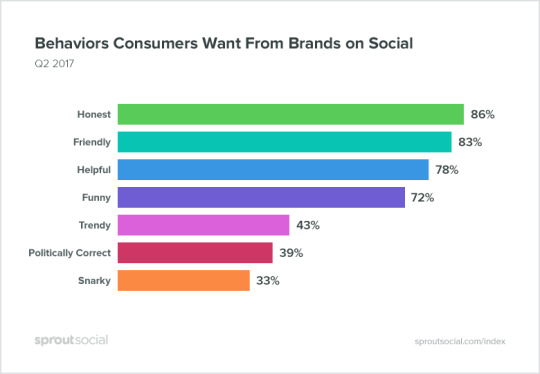
Sprout Social also found while 86% of users want to see a brand come to life on Facebook, only 27% of them want to see the same personality on Snapchat.
For an example of someone who demonstrates a ‘real’ approach, take a look at Twitter-crowned mogul Elon Musk:
Tunnels
— Elon Musk (@elonmusk) March 10, 2018
Elon Musk perfectly implements four of the seven desired brand traits with this tweet alone.
He’s honest: whatever you might think of The Boring Company’s progress or projects, they’re definitely ambitious. (I’d say they’re reaching for the stars, but that’s SpaceX.)
He’s friendly: is there any easier way to get people to laugh than to laugh with them? Poking fun at his own image and goals fosters a sense of connection.
Sure, he might be different from us, but he’s not disconnected. That matters.
By giving users the option of calling his tunnel system a “stupid hole in the ground” or an “impossible pipe dream,” he’s putting users in a place of power.
That matters even more.
Don’t do this. Also, I want to be clear that a flamethrower is a super terrible idea. Definitely don’t buy one. Unless you like fun.
A post shared by Elon Musk (@elonmusk) on Jan 27, 2018 at 5:29pm PST
Elon’s prowess isn’t limited to Twitter alone.
Look at his earlier Instagram post for the now-infamous “Not a Flamethrower.” He engages users with the same masterful sense of wit.
While we can’t all be Musk, we can take a page out of his book. He knows what people want from him on social media and delivers consistently.
More Than Personality
But the want for honesty and realness isn’t exclusive to personality alone: users also care a lot about a brand’s position on real-world events.
You may want to avoid the can of worms that come with political stances, but your users? They want to know where you fall on the issues.

Users identified education, immigration, and the environment as the most important issues for brands to take a position on.
So if you’re avoiding taking a stance on an issue or worried about seeming too unprofessional on social media, stop. The stats just don’t back up that approach.
The real human essence of the brand is what makes a brand worth someone’s time. They want to see that come through loud and clear.
For proof of how being social pays, look no further than Shareaholic’s 2017 Traffic Report.
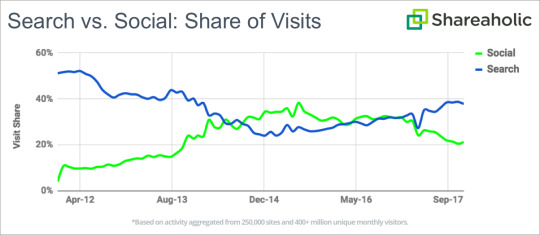
As you can see, although web traffic driven through social media has declined somewhat, it still accounts for 25.6% of visitors.
That’s 1 out of every 4 of your visitors. Borrowing a line from the mildly misquoted Queen of France, if your users want cake, let them have cake. You can’t afford not to.
Social sabotage #2: Forgetting to make room for new (older) users
The social sphere is changing. I know, I know: it’s always changing, but there’s more than just one new up-and-coming generation to contend with in your social media strategy.
All across the board, social media use is up among different age demographics and at its highest rate ever.
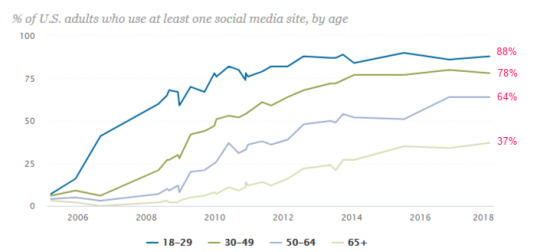
One of the most rapidly emerging user groups is the retirement age adult. They’re also one of the least talked about groups in social media marketing.
Increasing at a rate up to as much as one new user every 8 seconds until 2030, ignoring this user group as part of your social media strategy is untenable.
“But wait,” you say, “Doesn’t that user group have the lowest social media adoption rates?”
(Okay, maybe that’s not quite how you say it.)
Although that’s true, the answer isn’t as black and white as it seems.
When you look at social media’s rapid growth and increased technology adoption rates, it’s clear that social media isn’t strictly a “young man’s game”anymore.
To see this in action, look no further than total Internet users in the older adult demographic.
Up from 14% in 2010, a 2017 survey by the Pew Research Center reveals that 67% of respondents in the 65+ age group use the Internet on a regular basis.

Now that we’ve covered the importance of the older generation, what do you need to know to add them as an integral part of your user base on social media?
For one, that they’re not that different from their younger counterparts.
Like others, they use social media to foster personal connections, keep in touch with family, and are concerned about their privacy.
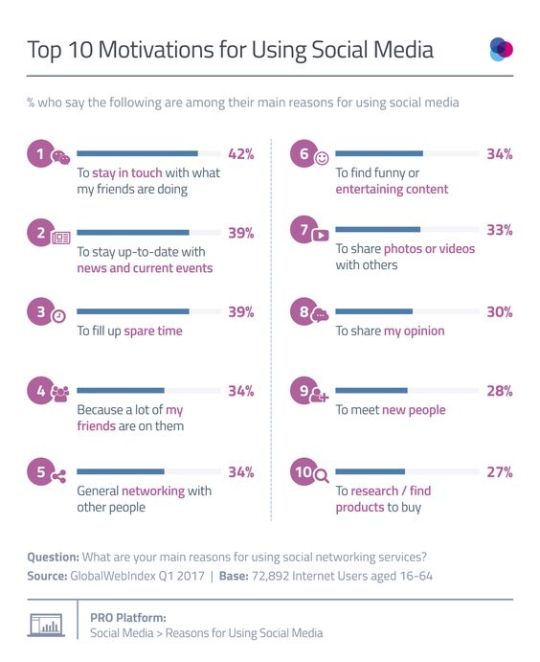
Unlike others, they sometimes struggle to suppress extraneous information and stimuli.
The W3C, the international organization which sets usability standards, has this to say about older adults:
“…cognitive ability – including reduced short-term memory, difficulty concentrating, and being easily distracted, making it difficult to follow navigation and complete online tasks.”
In other words, busy images, moving .gifs, and anything else that can tax their cognitive load can be a crippling barrier to social engagement.
For instance, take a look at one of Lay’s more recent tweets:
Need a date? Say hello to Sweet Southern Heat Barbecue!

pic.twitter.com/9Th7F8YDvu
— LAY'S (@LAYS) February 27, 2018
This tweet is simple and visually compelling while staying accessible for a wide variety of people.
On the other hand, consider this tweet:
Do you like coming up with chip flavors? Do you like chances at $1 Million? Then #DoUsAFlavor is for you! https://t.co/SEJyH6Azxx
— LAY'S (@LAYS) March 6, 2017
Highly saturated and featuring more than one focal point, the use of visuals here could potentially stress older adult users.
It may also exclude users who experience red-green color vision deficiency, which includes 1 in 12 men and 1 in 200 women.
Ensuring your social media is engaging requires keeping it accessible for every potential user group.
And with a population swiftly set to become 20% of the total United States population those user groups should include adults over the age of 65.

Here’s the bottom line: If you’re not including older adults as part of your social engagement strategy, you’re alienating a very large (and growing) user base.
Keep your posts simple, resist the urge to throw eye-bleed neon colors around it, and get to know your elders. They’re here to stay.
Social sabotage #3: Skipping movie day
You’re in fourth grade. You walk into the classroom to see a true and trusted friend: a bulky, unwieldy cart with a big screen TV the size of Arizona. Dimmed lights herald the elation of your classmates.
It’s movie day.
If you’re not recreating this experience for your audience, you’re missing out on engagement in a big way.
In a December 2017 survey, 83% of respondents said they would consider sharing relevant video content with their network.
And video is expected to keep growing by significant leaps.
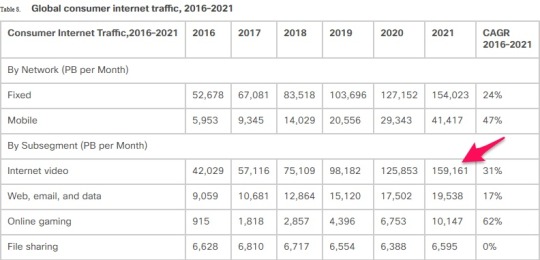
Cisco forecasts, “…Internet video streaming and downloads are beginning to take a larger share of bandwidth and will grow to more than 81 percent of all consumer Internet traffic by 2021.”
Does this mean that every post has to include a custom-made video? Unless you’re working with Elon Musk’s budget, then no, that probably won’t be the case.
But it should include a link to relevant video content, whether it’s a supplement or the show-stopper for your post.
Keep in mind that videos do more than make your posts more engaging. They make your brand more engaging.
Bill Shander, CEO and founder of Beehive Media, calls this transition the difference between “water cooler talk” and “the cafe.”

While the water cooler talk provides brief snippets and headlines, the cafe talk is a much deeper level of engagement. When users enter this stage, they commit more time to learning about the content and the brand associated with it.
There’s a reason I’m spending $144,000 on video content alone this year.
So the next time you post to social media, help your audience return to the days of yore with a timely, snappy video and make every post a movie day.
It’s that easy.
Social sabotage #4: Letting little errors cripple credibility
Have you ever written, proofed, polished, and double-checked a Facebook post or tweet, only to come back a few hours later and find a glaring typo?
“It’s not that bad,” you say, searching for the edit button anxiously, “Maybe no one else noticed.”
Unfortunately, that’s probably not true.
Making simple grammatical or spelling mistakes can tax your engagement and wallet significantly.
Consider this Q3 2017 report from Sprout Social about reactions to seeing other users issue “call-outs” on social media.

While this report looked at brand behaviors, the implication for being “called-out” on your mistakes is clear.
(And it will happen.)
It invites skepticism in first-time users and new customers. Skepticism, in turn, makes your conversion rate much harder to maintain.
But while that may not be surprising, what is surprising is the origin of many of these mistakes.
Basically, it’s your brain’s fault, not yours.
To understand how you make these mistakes, you have to get a little insight into… well, sight.
More specifically, you need to understand how your eyes and brain work together to perform the highly unnatural act of reading.
Here’s how it goes:
You read one word at a time. The places where your eyes rest are called fixations.
And you don’t actually read all of the words or the whole page.
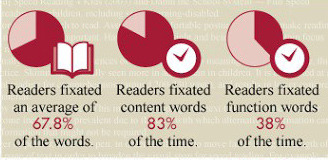
You just think you’re reading the whole page because your eyes are moving like the interstate at 4 am in a rapid series of saccades.
As you shift to each word with a saccade, your brain tries to offset the burden by anticipating and connecting the words ahead.
You don’t actually read most transition words (a, an, and, etc.) You just assume them.
Take a look at this graphic. Read the words first and then follow the arrows.
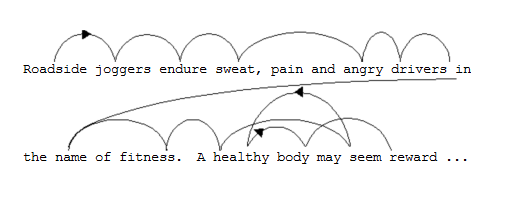
This represents the usual reading pattern of high-literacy readers. Do you notice how they skip short words entirely?
In fact, you rarely read words by the letter. You read most words as a whole according to their shape, according to Microsoft’s Mike Jacobs.
But what does that have to do with typos?
When you’re proofreading, you’re relying on the shape of the letters to create the architecture of the word.
Add to it that you’ve probably read the same thing six times in a row, and your brain starts filling in the details and cutting attentional corners.
You easily read “than” as “then.” “Is” becomes “as,” “an” becomes “and,” and so on.
Sure, you know the difference. But do your followers know you know? If not, your credibility will take a hit.
So will your budget if you’re discussing prices or rate changes on your social media channel.

(Unlike the New York City’s Metropolitan Transportation Authority’s $250,000 misprint, your social post should be easier to correct.)
But while there’s no definitive way to overcome this problem, there are a few steps you can take to mitigate it.
Here are some of the most popular techniques:
Walk away and coming back to proof later. It’s even better if it’s overnight.
Grab a second set of eyes. Their brains aren’t primed to autocorrect and can catch things faster.
Read your post aloud. Add funny voices if it helps. Disney characters can liven things up (and really confuse/concern your coworkers).
Use a service like Grammarly to catch contextual errors.
Social sabotage #5: Talking without listening
Social media is becoming the preferred medium for interaction. 56% of consumers report they’d rather fire off an emoji than pick up a phone.

Imagine their discontent when those brands are unresponsive.
Increasingly, customers and followers want more than just content: they want interaction.
Is the solution to respond to every single tweet, email, or comment? Sure, if it was possible. But it’s not.
Instead, you should focus on being aware of them and try to be at least marginally more engaging than a slab of concrete.
Enter social listening.
Social listening isn’t a spring chicken in technology anymore, but it may still be a new area for many fledgling marketers.
67% of marketing leaders report the use of social listening tools, while 20% report the intention to start using them in the coming year.

But don’t worry. If you missed out on the social listening train before or haven’t jumped on the automation track, you can still get your ticket.
Hootsuite is one of the most highly-ranked tools available. And best of all, it’s free for individuals for up to three social accounts.
Here’s how to turn your social ears up and get your listening game on point:
Head over to Hootsuite.

Hover over the word “plans” to see the drop-down menu and select the highlighted area for a free account.

Click on the green signup button.
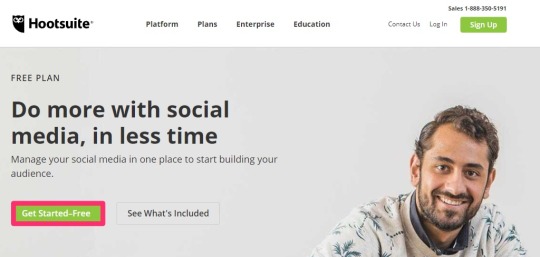
Fill in your information or link one of your social media accounts. You’ll need to link your accounts on the next screen, so feel free to use either option.
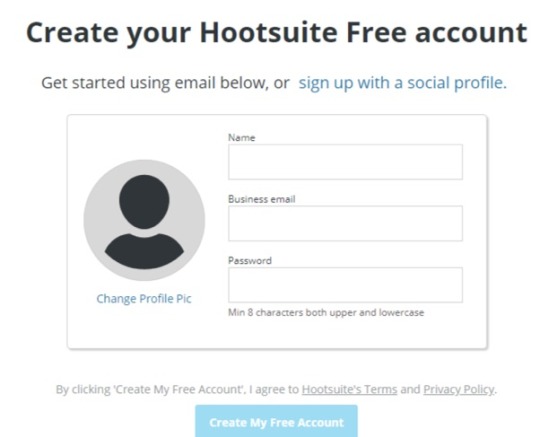
Link up to three social channels by clicking on their respective icons.
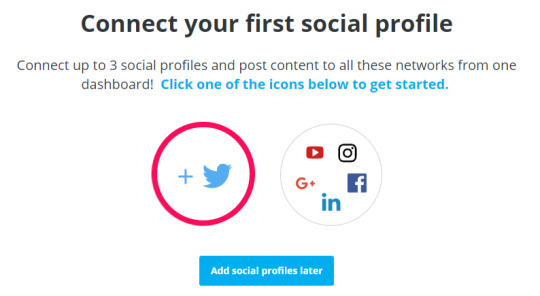
Fill out the last signup screen and click the blue submit button.

Rejoice! Open your new Hootsuite dashboard. Use the modal on the right to set up your first monitoring stream by clicking on the third option.

Your linked social media accounts should already be ready to go. Use the down arrow to toggle between accounts.
Open your “mentions” panel by clicking on the button with the large @ symbol. Peruse your mentions and start deciding who and how to reply.
Now that you have a bird’s-eye view on your social feeds, you can manage your engagement from one dashboard and never miss a beat with your followers.
In turn, you can engage them more. They’ll reciprocate by engaging you more.
So fire up that dashboard and start hitting “reply” to keep your fans happy and your critics soothed.
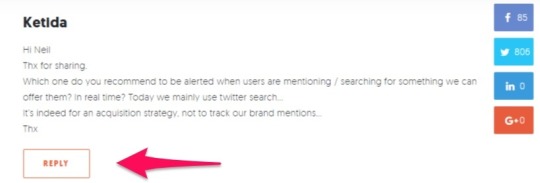
Conclusion
Social media engagement is critical for conversion rates and brand growth, but it’s easy to get wrong. Too easy.
People want more than just a branded message or trophy personality on social media. At its highest use rates ever, users clamor for honesty, friendliness, and humor from brands.
They also want brands to take real positions on real issues. Conventional strategy may say to avoid hot-button issues, but that isn’t what your users are saying. Listen to them.
Older adults are quickly rising up as one of the largest user populations and are expected to comprise one in every five people in the coming years in the US.
So if you’re not considering the baby boomers as part of your strategy, you’re missing out.
Videos resonate with people. You don’t have to produce a new video every time you put out a new post, but you should provide users with a relevant video option to dive deeper.
Small mistakes happen. Even the most polished and copyedited brands in the world let a typo slip through – it’s the human brain’s fault.
But your users won’t see it that way. Consistently letting errors pile up can put a serious damper on your engagement and credibility.
Those mistakes become cumulative, as does the damage to your brand.
It’s not enough to talk to your users: you need to be talking with them. Brands that interact with users on social media forge deeper connections and stronger followings.
Fortunately, there are a lot of great tools to help you keep track of social media conversations and take part. Hootsuite is one of the best and free for individuals.
If you’ve been committing these five social-sabotaging sins, it’s time to repent and make good. Give the people what they want, and you’ll get the engagement you want in return.
What’s been the most surprisingly successful engagement strategy for your brand?
About the Author: Neil Patel is the cofounder of Neil Patel Digital.
from Online Marketing Tips https://blog.kissmetrics.com/engaging-with-your-social-posts/
0 notes
Text
5 Reasons Why Nobody is Engaging With Your Social Posts (and How to Fix it)
Your content is poppin’. Polished and proofed, you’ve put this piece of content through the wringer to get it ready.
Now all you have to do is let people know where it is and wait for those likes, retweets, and accolades to start rolling in.
So you keep waiting.
And waiting.
Nothing happens. You might have built it, but the users aren’t coming to find it, contrary to the old adage. What gives?
Why isn’t your content (or product) getting the engagement you expected?
In 2018, if your social media strategy isn’t working in conjunction with your content strategy, you’re falling behind the curve.
There’s a reason 10% of professional marketers report social media marketing as the strategy most likely to yield big rewards in 2018.
The bad news: sabotaging your brand on social media is easy and potentially irreparable. If your social strategy isn’t getting the kind of engagement you want, you may be committing one of these five self-sabotaging social media sins:
Denying what people want
Forgetting to make room for new (older) users
Skipping movie day
Letting little errors cripple credibility
Talking without listening
The great news: I’m going to show you to fix them.
Social sabotage #1: Denying what people want
An estimated 73% of Americans report using YouTube. Facebook comes in at a respectable 68%. Instagram ranks as the third most popular platform at 35%.
Brand engagement and social media interactions are also on the rise. Nearly 50% of millennials and generation Xers follow brands on social media.
In other words, there’s never been a better opportunity or wider net to cast for social media engagement. But what users want from their social media experience with a brand may surprise you.
For one, they want something real.
They want real people, real interactions, and real, unbridled human connection. And they aren’t going to accept auto-spamming Twitter bots in place of it.
Social media users expect a lot out of a brand.
Sprout Social also found while 86% of users want to see a brand come to life on Facebook, only 27% of them want to see the same personality on Snapchat.
For an example of someone who demonstrates a ‘real’ approach, take a look at Twitter-crowned mogul Elon Musk:
Tunnels
— Elon Musk (@elonmusk) March 10, 2018
Elon Musk perfectly implements four of the seven desired brand traits with this tweet alone.
He’s honest: whatever you might think of The Boring Company’s progress or projects, they’re definitely ambitious. (I’d say they’re reaching for the stars, but that’s SpaceX.)
He’s friendly: is there any easier way to get people to laugh than to laugh with them? Poking fun at his own image and goals fosters a sense of connection.
Sure, he might be different from us, but he’s not disconnected. That matters.
By giving users the option of calling his tunnel system a “stupid hole in the ground” or an “impossible pipe dream,” he’s putting users in a place of power.
That matters even more.
Don’t do this. Also, I want to be clear that a flamethrower is a super terrible idea. Definitely don’t buy one. Unless you like fun.
A post shared by Elon Musk (@elonmusk) on Jan 27, 2018 at 5:29pm PST
Elon’s prowess isn’t limited to Twitter alone.
Look at his earlier Instagram post for the now-infamous “Not a Flamethrower.” He engages users with the same masterful sense of wit.
While we can’t all be Musk, we can take a page out of his book. He knows what people want from him on social media and delivers consistently.
More Than Personality
But the want for honesty and realness isn’t exclusive to personality alone: users also care a lot about a brand’s position on real-world events.
You may want to avoid the can of worms that come with political stances, but your users? They want to know where you fall on the issues.
Users identified education, immigration, and the environment as the most important issues for brands to take a position on.
So if you’re avoiding taking a stance on an issue or worried about seeming too unprofessional on social media, stop. The stats just don’t back up that approach.
The real human essence of the brand is what makes a brand worth someone’s time. They want to see that come through loud and clear.
For proof of how being social pays, look no further than Shareaholic’s 2017 Traffic Report.
As you can see, although web traffic driven through social media has declined somewhat, it still accounts for 25.6% of visitors.
That’s 1 out of every 4 of your visitors. Borrowing a line from the mildly misquoted Queen of France, if your users want cake, let them have cake. You can’t afford not to.
Social sabotage #2: Forgetting to make room for new (older) users
The social sphere is changing. I know, I know: it’s always changing, but there’s more than just one new up-and-coming generation to contend with in your social media strategy.
All across the board, social media use is up among different age demographics and at its highest rate ever.
One of the most rapidly emerging user groups is the retirement age adult. They’re also one of the least talked about groups in social media marketing.
Increasing at a rate up to as much as one new user every 8 seconds until 2030, ignoring this user group as part of your social media strategy is untenable.
“But wait,” you say, “Doesn’t that user group have the lowest social media adoption rates?”
(Okay, maybe that’s not quite how you say it.)
Although that’s true, the answer isn’t as black and white as it seems.
When you look at social media’s rapid growth and increased technology adoption rates, it’s clear that social media isn’t strictly a “young man’s game”anymore.
To see this in action, look no further than total Internet users in the older adult demographic.
Up from 14% in 2010, a 2017 survey by the Pew Research Center reveals that 67% of respondents in the 65+ age group use the Internet on a regular basis.
Now that we’ve covered the importance of the older generation, what do you need to know to add them as an integral part of your user base on social media?
For one, that they’re not that different from their younger counterparts.
Like others, they use social media to foster personal connections, keep in touch with family, and are concerned about their privacy.
Unlike others, they sometimes struggle to suppress extraneous information and stimuli.
The W3C, the international organization which sets usability standards, has this to say about older adults:
“…cognitive ability – including reduced short-term memory, difficulty concentrating, and being easily distracted, making it difficult to follow navigation and complete online tasks.”
In other words, busy images, moving .gifs, and anything else that can tax their cognitive load can be a crippling barrier to social engagement.
For instance, take a look at one of Lay’s more recent tweets:
Need a date? Say hello to Sweet Southern Heat Barbecue! pic.twitter.com/9Th7F8YDvu
— LAY'S (@LAYS) February 27, 2018
This tweet is simple and visually compelling while staying accessible for a wide variety of people.
On the other hand, consider this tweet:
Do you like coming up with chip flavors? Do you like chances at $1 Million? Then #DoUsAFlavor is for you! https://t.co/SEJyH6Azxx
— LAY'S (@LAYS) March 6, 2017
Highly saturated and featuring more than one focal point, the use of visuals here could potentially stress older adult users.
It may also exclude users who experience red-green color vision deficiency, which includes 1 in 12 men and 1 in 200 women.
Ensuring your social media is engaging requires keeping it accessible for every potential user group.
And with a population swiftly set to become 20% of the total United States population those user groups should include adults over the age of 65.
Here’s the bottom line: If you’re not including older adults as part of your social engagement strategy, you’re alienating a very large (and growing) user base.
Keep your posts simple, resist the urge to throw eye-bleed neon colors around it, and get to know your elders. They’re here to stay.
Social sabotage #3: Skipping movie day
You’re in fourth grade. You walk into the classroom to see a true and trusted friend: a bulky, unwieldy cart with a big screen TV the size of Arizona. Dimmed lights herald the elation of your classmates.
It’s movie day.
If you’re not recreating this experience for your audience, you’re missing out on engagement in a big way.
In a December 2017 survey, 83% of respondents said they would consider sharing relevant video content with their network.
And video is expected to keep growing by significant leaps.
Cisco forecasts, “…Internet video streaming and downloads are beginning to take a larger share of bandwidth and will grow to more than 81 percent of all consumer Internet traffic by 2021.”
Does this mean that every post has to include a custom-made video? Unless you’re working with Elon Musk’s budget, then no, that probably won’t be the case.
But it should include a link to relevant video content, whether it’s a supplement or the show-stopper for your post.
Keep in mind that videos do more than make your posts more engaging. They make your brand more engaging.
Bill Shander, CEO and founder of Beehive Media, calls this transition the difference between “water cooler talk” and “the cafe.”
While the water cooler talk provides brief snippets and headlines, the cafe talk is a much deeper level of engagement. When users enter this stage, they commit more time to learning about the content and the brand associated with it.
There’s a reason I’m spending $144,000 on video content alone this year.
So the next time you post to social media, help your audience return to the days of yore with a timely, snappy video and make every post a movie day.
It’s that easy.
Social sabotage #4: Letting little errors cripple credibility
Have you ever written, proofed, polished, and double-checked a Facebook post or tweet, only to come back a few hours later and find a glaring typo?
“It’s not that bad,” you say, searching for the edit button anxiously, “Maybe no one else noticed.”
Unfortunately, that’s probably not true.
Making simple grammatical or spelling mistakes can tax your engagement and wallet significantly.
Consider this Q3 2017 report from Sprout Social about reactions to seeing other users issue “call-outs” on social media.
While this report looked at brand behaviors, the implication for being “called-out” on your mistakes is clear.
(And it will happen.)
It invites skepticism in first-time users and new customers. Skepticism, in turn, makes your conversion rate much harder to maintain.
But while that may not be surprising, what is surprising is the origin of many of these mistakes.
Basically, it’s your brain’s fault, not yours.
To understand how you make these mistakes, you have to get a little insight into… well, sight.
More specifically, you need to understand how your eyes and brain work together to perform the highly unnatural act of reading.
Here’s how it goes:
You read one word at a time. The places where your eyes rest are called fixations.
And you don’t actually read all of the words or the whole page.
You just think you’re reading the whole page because your eyes are moving like the interstate at 4 am in a rapid series of saccades.
As you shift to each word with a saccade, your brain tries to offset the burden by anticipating and connecting the words ahead.
You don’t actually read most transition words (a, an, and, etc.) You just assume them.
Take a look at this graphic. Read the words first and then follow the arrows.
This represents the usual reading pattern of high-literacy readers. Do you notice how they skip short words entirely?
In fact, you rarely read words by the letter. You read most words as a whole according to their shape, according to Microsoft’s Mike Jacobs.
But what does that have to do with typos?
When you’re proofreading, you’re relying on the shape of the letters to create the architecture of the word.
Add to it that you’ve probably read the same thing six times in a row, and your brain starts filling in the details and cutting attentional corners.
You easily read “than” as “then.” “Is” becomes “as,” “an” becomes “and,” and so on.
Sure, you know the difference. But do your followers know you know? If not, your credibility will take a hit.
So will your budget if you’re discussing prices or rate changes on your social media channel.
(Unlike the New York City’s Metropolitan Transportation Authority’s $250,000 misprint, your social post should be easier to correct.)
But while there’s no definitive way to overcome this problem, there are a few steps you can take to mitigate it.
Here are some of the most popular techniques:
Walk away and coming back to proof later. It’s even better if it’s overnight.
Grab a second set of eyes. Their brains aren’t primed to autocorrect and can catch things faster.
Read your post aloud. Add funny voices if it helps. Disney characters can liven things up (and really confuse/concern your coworkers).
Use a service like Grammarly to catch contextual errors.
Social sabotage #5: Talking without listening
Social media is becoming the preferred medium for interaction. 56% of consumers report they’d rather fire off an emoji than pick up a phone.
Imagine their discontent when those brands are unresponsive.
Increasingly, customers and followers want more than just content: they want interaction.
Is the solution to respond to every single tweet, email, or comment? Sure, if it was possible. But it’s not.
Instead, you should focus on being aware of them and try to be at least marginally more engaging than a slab of concrete.
Enter social listening.
Social listening isn’t a spring chicken in technology anymore, but it may still be a new area for many fledgling marketers.
67% of marketing leaders report the use of social listening tools, while 20% report the intention to start using them in the coming year.
But don’t worry. If you missed out on the social listening train before or haven’t jumped on the automation track, you can still get your ticket.
Hootsuite is one of the most highly-ranked tools available. And best of all, it’s free for individuals for up to three social accounts.
Here’s how to turn your social ears up and get your listening game on point:
Head over to Hootsuite.
Hover over the word “plans” to see the drop-down menu and select the highlighted area for a free account.
Click on the green signup button.
Fill in your information or link one of your social media accounts. You’ll need to link your accounts on the next screen, so feel free to use either option.
Link up to three social channels by clicking on their respective icons.
Fill out the last signup screen and click the blue submit button.
Rejoice! Open your new Hootsuite dashboard. Use the modal on the right to set up your first monitoring stream by clicking on the third option.
Your linked social media accounts should already be ready to go. Use the down arrow to toggle between accounts.
Open your “mentions” panel by clicking on the button with the large @ symbol. Peruse your mentions and start deciding who and how to reply.
Now that you have a bird’s-eye view on your social feeds, you can manage your engagement from one dashboard and never miss a beat with your followers.
In turn, you can engage them more. They’ll reciprocate by engaging you more.
So fire up that dashboard and start hitting “reply” to keep your fans happy and your critics soothed.
Conclusion
Social media engagement is critical for conversion rates and brand growth, but it’s easy to get wrong. Too easy.
People want more than just a branded message or trophy personality on social media. At its highest use rates ever, users clamor for honesty, friendliness, and humor from brands.
They also want brands to take real positions on real issues. Conventional strategy may say to avoid hot-button issues, but that isn’t what your users are saying. Listen to them.
Older adults are quickly rising up as one of the largest user populations and are expected to comprise one in every five people in the coming years in the US.
So if you’re not considering the baby boomers as part of your strategy, you’re missing out.
Videos resonate with people. You don’t have to produce a new video every time you put out a new post, but you should provide users with a relevant video option to dive deeper.
Small mistakes happen. Even the most polished and copyedited brands in the world let a typo slip through – it’s the human brain’s fault.
But your users won’t see it that way. Consistently letting errors pile up can put a serious damper on your engagement and credibility.
Those mistakes become cumulative, as does the damage to your brand.
It’s not enough to talk to your users: you need to be talking with them. Brands that interact with users on social media forge deeper connections and stronger followings.
Fortunately, there are a lot of great tools to help you keep track of social media conversations and take part. Hootsuite is one of the best and free for individuals.
If you’ve been committing these five social-sabotaging sins, it’s time to repent and make good. Give the people what they want, and you’ll get the engagement you want in return.
What’s been the most surprisingly successful engagement strategy for your brand?
About the Author: Neil Patel is the cofounder of Neil Patel Digital.
5 Reasons Why Nobody is Engaging With Your Social Posts (and How to Fix it)
0 notes
Text
My Reflections After Attending Social Media Marketing World
My wife asked me not to post that I was going to Social Media Marketing World last week.
She wasn’t comfortable with my social media friends knowing that she was home alone with the kids.
At first, I was disappointed.
Listen to the Episode
I was going to be in San Diego at a SOCIAL MEDIA conference without posting about it on social media.
Then, I accepted it. It was what it was. Yes, I would miss out on some of the benefits of being at an event, but I would survive.
But something different happened – I didn’t actually miss out. In fact, I got more out of the conference.
The People at Social Media Marketing World 2017 Photo Credit: SMMW Facebook Page
What I accomplished
The beauty of being at the conference without trying to share it with the world is that I was able to be present.
As a result, I was able to :
Connect with a few bloggers in a much deeper way than I would otherwise
Record 26 video interviews
Do some long-term strategic planning for my business
I can confidently say that this has been my most productive conference to date.
My Reflections:
When thinking back on my experience, there are a few things that stand out.
I'd like to share some of my reflections with you…
Being present is better than trying to be everywhere else.
This is something I touched on in my last podcast episode.
While at the conference, I had many different experiences.
Photo Credit: Jennifer Cole's Facebook page
Many of the attendees were trying to share the experience with everyone else.
Since I decided not to, I was able to embrace the moment.
I focused on the conversations I was having while eating instead of sharing pictures of my food..
I was able to look into the eyes of the people I spoke to and show them that what they were saying was important to me.
Instead of making videos at the parties, I was able to enjoy my dance.
Planning and goal-setting makes a HUGE difference.
Photo Credits (Top – Bottom): Wendy Marrow Grubbs, Denis Wakeman, Amanda Robinson, Kelly Baader, @premierexmedia, Natchi Lazarus, Bucky Beeman, Ai Addyson-Zhang
I've attended many conferences to date.
This was my most productive conference. Why? Because I had two very specific goals.
One goal was to record a bunch of interviews. My second goal was to connect deeply with a few specific individuals.
I accomplished both, and that will be big for my business.
Going deep is better than casting a wide net (for me).
There's one thing I've come to know about myself. I value relationships.
But not any kind of relationship. It's not just about knowing a bunch of people.
From left to right: Andy Traub, Erik Fisher, Jeff Sieh, Leslie Samuel, Juan Felix and Jennifer Cole Photo Credits: Erik Fisher's Facebook Page
It's about getting to know a few people very well. My goal wasn't to walk away with tons of new relationships.
It was to nurture a few key relationships in a deep way, and that paid off.
It's important to have a vision.
I'm impressed by Michael Stelzner's vision for Social Media Examiner.
Leslie at SMMW2017 Photo Credit: SMMW Facebook Page
Their vision statement is “All we serve is quality and we serve all with excellence”.
But it's not just a vision statement that is displayed on a wall somewhere. It's a commitment they've made to their audience.
It's a commitment that's reinforced in all meetings and in all they do.
This was tangible in all aspects of the conference and makes me want to strive to do the same thing in my business.
Pay attention to the details that align with your vision.
I know what you're thinking – this is obvious from the last point.
But what really impressed me is how this was emphasized even in the little things.
Here's an example . . .
One of the main focuses of the conference is on the importance of networking.
They had toothbrushes and toothpaste in all restrooms to help to make the verbal networking experience a pleasant one.
If that's not attention to detail, I don't know what else is.
It's essential to build a team.
SMMW 2017 Team Photo credit: Mike Stelzner's Facebook page
Social Media Marketing World is a HUGE event. An event of that caliber needs a strong team.
There were hundreds of people working to make the event a success.
As I build my blog, I want to focus more on building a strong, cohesive team.
Visuals are more important than ever.
Visual are important
41% of marketers claim visuals are the most important form of content, more than blogging, videos and podcasting.
That's a huge deal.
I have gotten much better at focusing on visuals (as you can tell by this post). But I want to make it even more of a priority as I move forward.
Video, video, video (especially live).
There's a lot happening in the online video space, and especially with live video.
Video is something I enjoy doing and is an area that I want to spend more time on.
I've already been dabbling with live video, but you can expect to see more coming from me soon.
Message Bots
Messenger bots are the next big thing.
As much as I love my email list and still see it as one of my most valuable assets, open rates are declining over time.
However, messenger bots are still very new and the open rates are astonishing. It’s something I’ve been experimenting with and will continue to do so.
As I learn, I will share with you.
Question for you
Of these nine points of reflection, which do you resonate with most? Let me know in the comments below.
Infographic
The post My Reflections After Attending Social Media Marketing World appeared first on Become A Blogger by Leslie Samuel.
from Lauren Cameron Updates http://www.becomeablogger.com/24562/reflections-smmw/
0 notes
Text
My Reflections After Attending Social Media Marketing World
My wife asked me not to post that I was going to Social Media Marketing World last week.
She wasn’t comfortable with my social media friends knowing that she was home alone with the kids.
At first, I was disappointed.
Listen to the Episode
I was going to be in San Diego at a SOCIAL MEDIA conference without posting about it on social media.
Then, I accepted it. It was what it was. Yes, I would miss out on some of the benefits of being at an event, but I would survive.
But something different happened – I didn’t actually miss out. In fact, I got more out of the conference.
The People at Social Media Marketing World 2017 Photo Credit: SMMW Facebook Page
What I accomplished
The beauty of being at the conference without trying to share it with the world is that I was able to be present.
As a result, I was able to :
Connect with a few bloggers in a much deeper way than I would otherwise
Record 26 video interviews
Do some long-term strategic planning for my business
I can confidently say that this has been my most productive conference to date.
My Reflections:
When thinking back on my experience, there are a few things that stand out.
I'd like to share some of my reflections with you…
Being present is better than trying to be everywhere else.
This is something I touched on in my last podcast episode.
While at the conference, I had many different experiences.
Photo Credit: Jennifer Cole's Facebook page
Many of the attendees were trying to share the experience with everyone else.
Since I decided not to, I was able to embrace the moment.
I focused on the conversations I was having while eating instead of sharing pictures of my food..
I was able to look into the eyes of the people I spoke to and show them that what they were saying was important to me.
Instead of making videos at the parties, I was able to enjoy my dance.
Planning and goal-setting makes a HUGE difference.
Photo Credits (Top – Bottom): Wendy Marrow Grubbs, Denis Wakeman, Amanda Robinson, Kelly Baader, @premierexmedia, Natchi Lazarus, Bucky Beeman, Ai Addyson-Zhang
I've attended many conferences to date.
This was my most productive conference. Why? Because I had two very specific goals.
One goal was to record a bunch of interviews. My second goal was to connect deeply with a few specific individuals.
I accomplished both, and that will be big for my business.
Going deep is better than casting a wide net (for me).
There's one thing I've come to know about myself. I value relationships.
But not any kind of relationship. It's not just about knowing a bunch of people.
From left to right: Andy Traub, Erik Fisher, Jeff Sieh, Leslie Samuel, Juan Felix and Jennifer Cole Photo Credits: Erik Fisher's Facebook Page
It's about getting to know a few people very well. My goal wasn't to walk away with tons of new relationships.
It was to nurture a few key relationships in a deep way, and that paid off.
It's important to have a vision.
I'm impressed by Michael Stelzner's vision for Social Media Examiner.
Leslie at SMMW2017 Photo Credit: SMMW Facebook Page
Their vision statement is “All we serve is quality and we serve all with excellence”.
But it's not just a vision statement that is displayed on a wall somewhere. It's a commitment they've made to their audience.
It's a commitment that's reinforced in all meetings and in all they do.
This was tangible in all aspects of the conference and makes me want to strive to do the same thing in my business.
Pay attention to the details that align with your vision.
I know what you're thinking – this is obvious from the last point.
But what really impressed me is how this was emphasized even in the little things.
Here's an example . . .
One of the main focuses of the conference is on the importance of networking.
They had toothbrushes and toothpaste in all restrooms to help to make the verbal networking experience a pleasant one.
If that's not attention to detail, I don't know what else is.
It's essential to build a team.
SMMW 2017 Team Photo credit: Mike Stelzner's Facebook page
Social Media Marketing World is a HUGE event. An event of that caliber needs a strong team.
There were hundreds of people working to make the event a success.
As I build my blog, I want to focus more on building a strong, cohesive team.
Visuals are more important than ever.
Visual are important
41% of marketers claim visuals are the most important form of content, more than blogging, videos and podcasting.
That's a huge deal.
I have gotten much better at focusing on visuals (as you can tell by this post). But I want to make it even more of a priority as I move forward.
Video, video, video (especially live).
There's a lot happening in the online video space, and especially with live video.
Video is something I enjoy doing and is an area that I want to spend more time on.
I've already been dabbling with live video, but you can expect to see more coming from me soon.
Message Bots
Messenger bots are the next big thing.
As much as I love my email list and still see it as one of my most valuable assets, open rates are declining over time.
However, messenger bots are still very new and the open rates are astonishing. It’s something I’ve been experimenting with and will continue to do so.
As I learn, I will share with you.
Question for you
Of these nine points of reflection, which do you resonate with most? Let me know in the comments below.
Infographic
The post My Reflections After Attending Social Media Marketing World appeared first on Become A Blogger by Leslie Samuel.
from Julia Garza Social Media Tips http://www.becomeablogger.com/24562/reflections-smmw/
0 notes
Text
Something's Missing From the Victoria's Secret Fashion Show, and You Already Know What It Is
Image Source: Getty Images/Fred Dufour
The last time I walked into Victoria's Secret and treated myself to red silk coordinates for Valentine's Day, it was because I wanted to feel sexy. That's what I love about the brand: it encourages women to embrace their inner sexiness, and I think that's important. Whether it's buying a new push-up bra or investing in one of the signature VS body scents, a woman should make herself feel desirable by shopping for underthings, if that's what she wants. At Victoria's Secret, there are so many high-quality pieces that cater to a wide range of tastes. Every time I walk into the store, my eyes widen at some sort of luxurious looking lingerie set (I really love shopping for lingerie).
Maybe I made the wrong selection on this aforementioned Valentine's Day. The push-up bra, strappy panties, and satin sash that was somehow supposed to wrap through a loop somewhere, then crisscross around my midriff and tuck into the waist belt (What?) ended up being a $150 look I simply couldn't pull off. I definitely didn't look like Lily Aldridge in this thing, but according to the images on the website, it should've been at least possible to wear correctly. Even though I bought the right cup size and I definitely know my waist measurements, the ensemble just wasn't right for me. It just didn't fit - my confidence level, more than anything.
At this point, I have exactly three unused Victoria's Secret gift cards tucked away in my wallet, and there's a good chance they've expired. It's not because I forgot about them - those glittery pink rectangles stand out way more than my office building entry pass and even my Frozen-themed Disney Visa. And it's not because I don't like Victoria's Secret. But the image the brand has projected lately and the lineup of Angels - all of whom have virtually the same figure - feel a little bit discouraging.
That's not to say I don't look forward to the annual VS runway, or that I don't understand the excitement behind finding out who's opening each section of the show. If you follow celebrity relationships and you love the personalities of all the different models, it's always interesting when one of them is best friends with the performer (Remember Karlie Kloss and Taylor Swift's adorable interaction in 2014?) or if, perhaps, the dude singing on stage is the hot new Angel's ex (flashback to Bella Hadid and The Weeknd). With all the glitz and the confetti that falls on the scene, this spectacle is a form of entertainment, and it's damn fun to watch. But it's impossible to ignore how similar the women all look as they strut on by.
The Prototypical Angel
Image Source: Getty Images/Matt Winkelmeyer
I've met a lot of Victoria's Secret models in the flesh, and they really do look exactly like you see in the pictures. They're really that tall; they really have that flawless skin, the hair you want after a visit to the salon but never end up with, and that toned-enough-for-a-six-pack but thin-enough-to-look-capital-S-skinny ab situation. They really don't appear to have any cellulite.
Of course, these women have access to camera-friendly, air-brushed makeup and quality body glitter and cover-up, and I haven't seen them all in a thong, but I've seen a bunch of them wearing little to nothing up close and attended the Victoria's Secret Fashion Shows. I can promise you that my body looks so different from theirs in lingerie, I might as well be another species.
And here's the thing: I'm petite, and while I have athletic legs, I am not particularly curvy. What about the women who are? Do they want anything to do with Victoria's Secret? Do they feel angry at or limited by the photos of the Angels on the retailer's site? Do they roll their eyes at the girls on the runway or feel saddened by the lack of diversity? My guess is that, like me, they do.
Where Are All the Curve Models?
Victoria's Secret is America's largest lingerie company. It's owned by the Les Wexner and family business L Brands, which has a current net worth of $5 billion. It's everywhere - plastered on one of the biggest billboards in Times Square, on your TV screen, and in the pages of the magazines you read.
While the runways at Fashion Week are continuing to become more diverse - at Christian Siriano, Chromat, and Prabal Gurung, to name a select few - there is still no cemented acceptance of difference in the fashion industry, only the possibility of acknowledgment. Many designers make an effort by including just one curve model on the runway. In my opinion, that is absolutely not enough. But at Victoria's Secret, there isn't just one curve model - there are none.
In Victoria's Secret's defense, the brand has made it a point to include women of color and various backgrounds and ethnicities in its casting - both on the runway and in shoots - but they still all seem to fit a certain "look," as far as size is concerned.
Image Source: Getty Images/Angela Weiss
Curve models with large social media platforms have publicly acknowledged, in various ways, that they realize they don't fit the Victoria's Secret mold. It was Ashley Graham who, in 2017, posted a photo of herself on Instagram modeling for Addition Elle, a size-inclusive lingerie brand she works with and designs for, on the exact same day the VS show was being filmed in Shanghai. She wrote, "Got my wings! My #AdditionElle wings! #ThickThighsSaveLives." Curve model Tabria Majors has also re-created Victoria's Secret campaigns in order to "revisit the conversation of average-sized women being represented in mainstream media."
Of course, we can't be positive that Ashley Graham was taking a jab at the brand, but she was certainly comparing another popular lingerie line to the powerhouse that is Victoria's Secret. I've been to an Addition Elle runway show, which includes models of all shapes and sizes, and there's something so comfortable about seeing them debut the new bras and panties. When they walk, their butt cheeks jiggle. A lot of them have gorgeous pear figures, and they're rocking flattering bustiers or camisoles that accentuate and draw attention to body parts of their choice. "Yeah," I thought when I saw them. "That's what I look like in lingerie." And these girls do look just as confident as the likes of Alessandra Ambrosio and Adriana Lima, who are VS vets that strutted their stuff for years.
I'm definitely not the only one in fashion who notices this clear juxtaposition. Director of Vogue Runway Nicole Phelps uploaded a row of diverse runway shots on the day of the 2017 VS show, all of which celebrate diversity in body type, age, and clothing taste (i.e., modest dressing). "In honor of the Victoria's Secret Fashion Show, a reminder, courtesy of Chromat and Becca McCharen-Tran, that the battle for true diversity on the runway is ongoing. #SizeDiversity," she wrote.
Is Time Running Out?
Image Source: Getty Images/KMazur/WireImage // Getty Images/Frank Micelotta // Getty Images/Gregory Pace/FilmMagic
Has Victoria's Secret always been lacking in size diversity? Well, not exactly. Throughout the years, there have been some iconic Angels, such as Naomi Campbell, Heidi Klum, and Tyra Banks, who were more shapely than shockingly thin. But as the years passed and these supermodels hung up their wings - Naomi and Tyra in 2005 and Heidi in 2009 - the media began to embrace an increasingly svelte woman. Victoria's Secret put her on a pedestal by featuring this idealized figure in all its ads and certainly on all its runways. This single-track version of unattainable perfection is what Victoria's Secret continues to publicize today.
That's why sometimes, on days I feel a little more self-conscious than others, walking into a Victoria's Secret can feel daunting. If I do happen to feel sexy, I'll probably march right into the store and see if my gift cards have expired and whether I still have a balance left to use. But it won't be on the same day as the Victoria's Secret runway taping, nor the day the sparkly, mystical extravaganza airs on CBS. Probably not the day after either. That's because, in a way, I feel excluded from that runway - as though that very limited idea of beauty doesn't apply to me. Not one of those girls is 5'1" with athletic thighs and a double A cup. Can you imagine how many other women and girls feel discouraged, too?
A company as big as Victoria's Secret can and should have an answer for the rest of us, and it should start with the spectacle that is the runway show. It didn't happen in LA in 2006, in Miami in 2008, in London in 2014, nor in Paris in 2016. In 2017 it didn't happen in Shanghai, and not in 2018 in New York. The model lineups on those catwalks all looked the same to me. I don't know about my gift cards, but I wonder: what's the expiration date on this same old show where body diversity is never a theme?
Related:
12 Body-Image Quotes From Victoria's Secret Angels That Are Totally Relatable
Something's Missing From the Victoria's Secret Fashion Show, and You Already Know What It Is published first on http://wholesalescarvescity.blogspot.com
0 notes